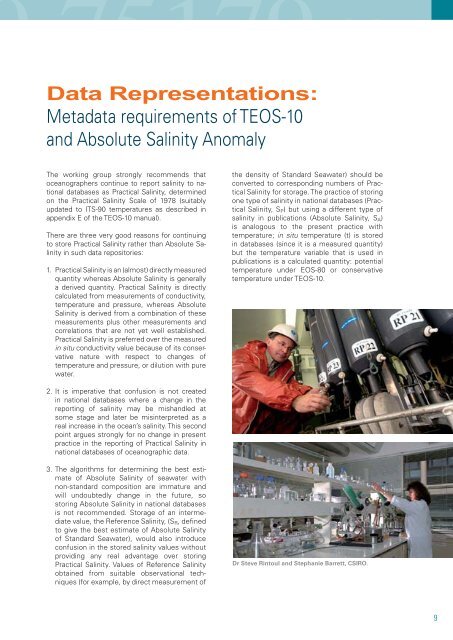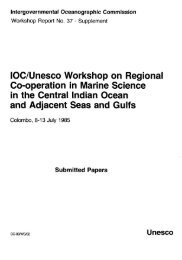The International thermodynamic equation of ... - unesdoc - Unesco
The International thermodynamic equation of ... - unesdoc - Unesco
The International thermodynamic equation of ... - unesdoc - Unesco
- No tags were found...
You also want an ePaper? Increase the reach of your titles
YUMPU automatically turns print PDFs into web optimized ePapers that Google loves.
.75179 γData Representations:Metadata requirements <strong>of</strong> TEOS-10and Absolute Salinity Anomaly<strong>The</strong> working group strongly recommends thatoceanographers continue to report salinity to nationaldatabases as Practical Salinity, determinedon the Practical Salinity Scale <strong>of</strong> 1978 (suitablyupdated to ITS-90 temperatures as described inappendix E <strong>of</strong> the TEOS-10 manual).<strong>The</strong>re are three very good reasons for continuingto store Practical Salinity rather than Absolute Salinityin such data repositories:1. Practical Salinity is an (almost) directly measuredquantity whereas Absolute Salinity is generallya derived quantity. Practical Salinity is directlycalculated from measurements <strong>of</strong> conductivity,temperature and pressure, whereas AbsoluteSalinity is derived from a combination <strong>of</strong> thesemeasurements plus other measurements andcorrelations that are not yet well established.Practical Salinity is preferred over the measuredin situ conductivity value because <strong>of</strong> its conservativenature with respect to changes <strong>of</strong>temperature and pressure, or dilution with purewater.2. It is imperative that confusion is not createdin national databases where a change in thereporting <strong>of</strong> salinity may be mishandled atsome stage and later be misinterpreted as areal increase in the ocean’s salinity. This secondpoint argues strongly for no change in presentpractice in the reporting <strong>of</strong> Practical Salinity innational databases <strong>of</strong> oceanographic data.the density <strong>of</strong> Standard Seawater) should beconverted to corresponding numbers <strong>of</strong> PracticalSalinity for storage. <strong>The</strong> practice <strong>of</strong> storingone type <strong>of</strong> salinity in national databases (PracticalSalinity, S P ) but using a different type <strong>of</strong>salinity in publications (Absolute Salinity, S A )is analogous to the present practice withtemperature; in situ temperature (t) is storedin databases (since it is a measured quantity)but the temperature variable that is used inpublications is a calculated quantity: potentialtemperature under EOS-80 or conservativetemperature under TEOS-10.3. <strong>The</strong> algorithms for determining the best estimate<strong>of</strong> Absolute Salinity <strong>of</strong> seawater withnon-standard composition are immature andwill undoubtedly change in the future, sostoring Absolute Salinity in national databasesis not recommended. Storage <strong>of</strong> an intermediatevalue, the Reference Salinity, (S R , definedto give the best estimate <strong>of</strong> Absolute Salinity<strong>of</strong> Standard Seawater), would also introduceconfusion in the stored salinity values withoutproviding any real advantage over storingPractical Salinity. Values <strong>of</strong> Reference Salinityobtained from suitable observational techniques(for example, by direct measurement <strong>of</strong>Dr Steve Rintoul and Stephanie Barrett, CSIRO.9
















